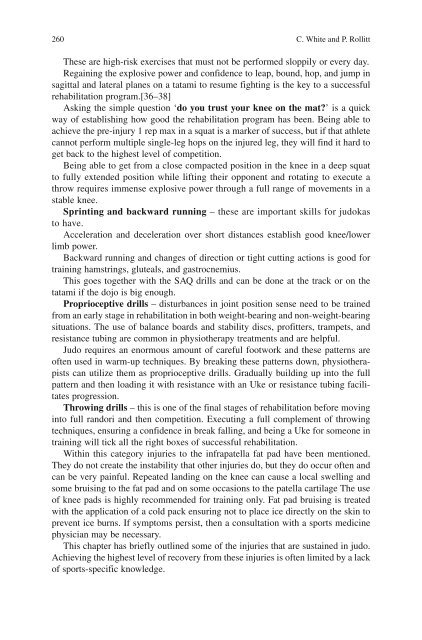Nutrition in Combat Sports
Nutrition in Combat Sports
Nutrition in Combat Sports
Create successful ePaper yourself
Turn your PDF publications into a flip-book with our unique Google optimized e-Paper software.
260 C. White and P. Rollitt<br />
These are high-risk exercises that must not be performed sloppily or every day.<br />
Rega<strong>in</strong><strong>in</strong>g the explosive power and confidence to leap, bound, hop, and jump <strong>in</strong><br />
sagittal and lateral planes on a tatami to resume fight<strong>in</strong>g is the key to a successful<br />
rehabilitation program. [36–38]<br />
Ask<strong>in</strong>g the simple question ‘ do you trust your knee on the mat? ’ is a quick<br />
way of establish<strong>in</strong>g how good the rehabilitation program has been. Be<strong>in</strong>g able to<br />
achieve the pre-<strong>in</strong>jury 1 rep max <strong>in</strong> a squat is a marker of success, but if that athlete<br />
cannot perform multiple s<strong>in</strong>gle-leg hops on the <strong>in</strong>jured leg, they will f<strong>in</strong>d it hard to<br />
get back to the highest level of competition.<br />
Be<strong>in</strong>g able to get from a close compacted position <strong>in</strong> the knee <strong>in</strong> a deep squat<br />
to fully extended position while lift<strong>in</strong>g their opponent and rotat<strong>in</strong>g to execute a<br />
throw requires immense explosive power through a full range of movements <strong>in</strong> a<br />
stable knee.<br />
Spr<strong>in</strong>t<strong>in</strong>g and backward runn<strong>in</strong>g – these are important skills for judokas<br />
to have.<br />
Acceleration and deceleration over short distances establish good knee/lower<br />
limb power.<br />
Backward runn<strong>in</strong>g and changes of direction or tight cutt<strong>in</strong>g actions is good for<br />
tra<strong>in</strong><strong>in</strong>g hamstr<strong>in</strong>gs, gluteals, and gastrocnemius.<br />
This goes together with the SAQ drills and can be done at the track or on the<br />
tatami if the dojo is big enough.<br />
Proprioceptive drills – disturbances <strong>in</strong> jo<strong>in</strong>t position sense need to be tra<strong>in</strong>ed<br />
from an early stage <strong>in</strong> rehabilitation <strong>in</strong> both weight-bear<strong>in</strong>g and non-weight-bear<strong>in</strong>g<br />
situations. The use of balance boards and stability discs, profitters, trampets, and<br />
resistance tub<strong>in</strong>g are common <strong>in</strong> physiotherapy treatments and are helpful.<br />
Judo requires an enormous amount of careful footwork and these patterns are<br />
often used <strong>in</strong> warm-up techniques. By break<strong>in</strong>g these patterns down, physiotherapists<br />
can utilize them as proprioceptive drills. Gradually build<strong>in</strong>g up <strong>in</strong>to the full<br />
pattern and then load<strong>in</strong>g it with resistance with an Uke or resistance tub<strong>in</strong>g facilitates<br />
progression.<br />
Throw<strong>in</strong>g drills – this is one of the f<strong>in</strong>al stages of rehabilitation before mov<strong>in</strong>g<br />
<strong>in</strong>to full randori and then competition. Execut<strong>in</strong>g a full complement of throw<strong>in</strong>g<br />
techniques, ensur<strong>in</strong>g a confidence <strong>in</strong> break fall<strong>in</strong>g, and be<strong>in</strong>g a Uke for someone <strong>in</strong><br />
tra<strong>in</strong><strong>in</strong>g will tick all the right boxes of successful rehabilitation.<br />
With<strong>in</strong> this category <strong>in</strong>juries to the <strong>in</strong>frapatella fat pad have been mentioned.<br />
They do not create the <strong>in</strong>stability that other <strong>in</strong>juries do, but they do occur often and<br />
can be very pa<strong>in</strong>ful. Repeated land<strong>in</strong>g on the knee can cause a local swell<strong>in</strong>g and<br />
some bruis<strong>in</strong>g to the fat pad and on some occasions to the patella cartilage The use<br />
of knee pads is highly recommended for tra<strong>in</strong><strong>in</strong>g only. Fat pad bruis<strong>in</strong>g is treated<br />
with the application of a cold pack ensur<strong>in</strong>g not to place ice directly on the sk<strong>in</strong> to<br />
prevent ice burns. If symptoms persist, then a consultation with a sports medic<strong>in</strong>e<br />
physician may be necessary.<br />
This chapter has briefly outl<strong>in</strong>ed some of the <strong>in</strong>juries that are susta<strong>in</strong>ed <strong>in</strong> judo.<br />
Achiev<strong>in</strong>g the highest level of recovery from these <strong>in</strong>juries is often limited by a lack<br />
of sports-specific knowledge.

















